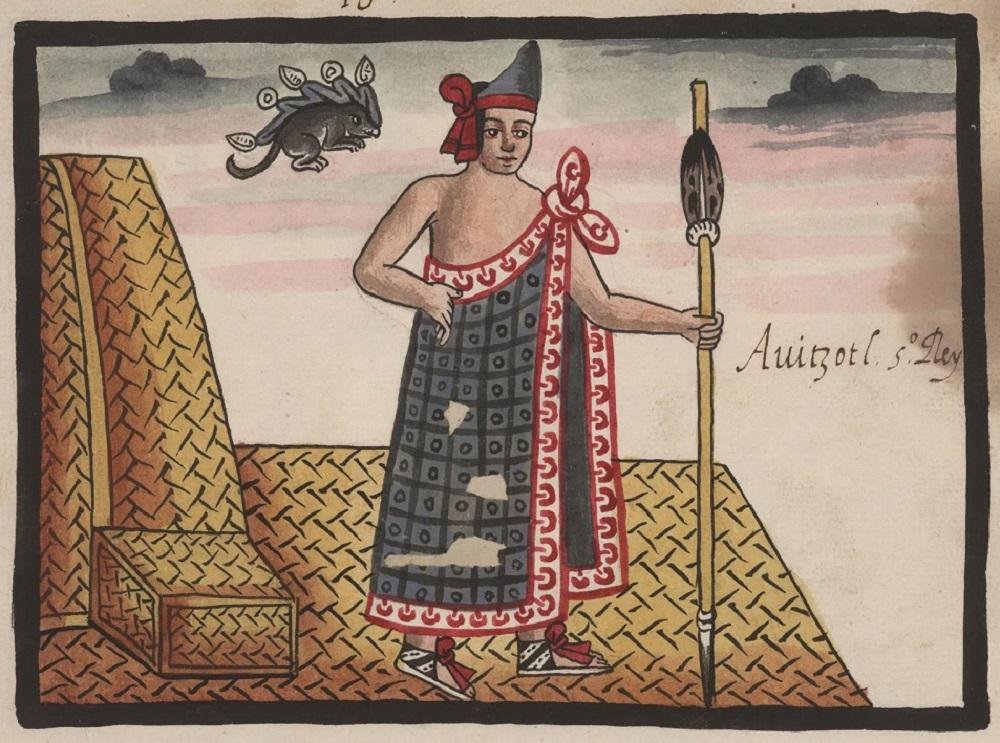A recent analysis of the Hueyi Tzompantli—the mᴀssive Aztec skull rack unearthed near the Templo Mayor ruins in the heart of modern-day Mexico City—has revealed a surprisingly high number of female skulls. Researchers now believe these remains may be directly connected to the Aztec myth of Huitzilopochtli, the sun and war god.
 Ahuitzotl, watercolour illustration from the Codex Tovar by Juan de Tovar, late 16th century. Credit: Courtesy of the John Carter Brown Library (CC BY 4.0)
Ahuitzotl, watercolour illustration from the Codex Tovar by Juan de Tovar, late 16th century. Credit: Courtesy of the John Carter Brown Library (CC BY 4.0)
Speaking at an event hosted by Mexico’s National Insтιтute of Anthropology and History (INAH), archaeologist Raúl Barrera Rodríguez suggested that the Aztecs could have sacrificed large numbers of women in symbolic rituals meant to re-create the legendary battle between Huitzilopochtli and his sister Coyolxauhqui, the moon goddess.
According to Aztec mythology, Huitzilopochtli was born fully armed and immediately engaged in a cosmic battle against his siblings, led by Coyolxauhqui, whom he ultimately dismembered. This myth, central to Aztec cosmology, reflects a struggle between solar and lunar forces and served as a justification for continual warfare and ritual sacrifice.
Discovery and Construction of the Hueyi Tzompantli
The Hueyi Tzompantli, or “Great Skull Rack,” was discovered in 2015, with a second section revealed in 2018. It was constructed in three stages between CE 1486 and 1502, during the reign of the Aztec ruler Ahuitzotl, the eighth Huey Tlatoani (Great Speaker) of Tenochтιтlan. Known for expanding the empire and rebuilding the Templo Mayor, Ahuitzotl dedicated much of his rule to bolstering religious devotion through monumental architecture and public rituals, including human sacrifice.
The tzompantli itself was designed to display the skulls of captured enemies and ritual victims. During sacrificial ceremonies at the Templo Mayor, priests would extract the victim’s still-beating heart and offer it to Huitzilopochtli before decapitating the body. The skulls were then placed on the tzompantli in horizontal rows, likely affixed with wooden poles.
Composition of the Skull Rack
According to the most recent study, the Hueyi Tzompantli comprises 655 human skulls. Of these:
60% belong to males aged 25 to 35, presumed to be captured warriors.
38% are identified as female.
2% belong to infants or young children.
While male warrior captives were expected victims of war-related sacrifices, the high percentage of female skulls has prompted new interpretations. “Historical sources contain few mentions of female warriors,” said Barrera Rodríguez, “though we know that women who died in childbirth were accorded the same heroic status as men who died in battle.”
He also cited Spanish chronicler Francisco de Aguilar, who noted that during the final siege of Tenochтιтlan in 1521, many Aztec women took up arms alongside the city’s defenders. This detail supports the possibility that some of the women sacrificed may have been recognized as warrior figures.
Mythological Role of Women and Children
The presence of female skulls may also point to ritual reenactments of the myth of Huitzilopochtli, where sacrificial victims embodied mythic roles. In the origin story, Huitzilopochtli is said to have slain Coyolxauhqui in a dramatic celestial conflict. By sacrificing women, the Aztecs may have sought to ritually reproduce this event, reaffirming the cosmic order and the dominance of the sun.
The children’s skulls, though few, present another layer of complexity. While their specific roles remain unclear, Barrera Rodríguez speculates that they may have represented the infant Huitzilopochtli in ritual performances of his divine birth.
Broader Implications
The Hueyi Tzompantli offers a powerful glimpse into Aztec religious ideology, social hierarchy, and gender roles. It reveals a culture where myth and ritual were тιԍнтly intertwined with statecraft and warfare. The prominence of female and child victims suggests that sacrificial practices extended beyond enemy warriors to include symbolic reenactments involving multiple layers of meaning.
The findings also reflect the Aztecs’ deep commitment to their deities and the cyclical worldview that required constant offerings to maintain cosmic balance. As archaeologists continue to study the Hueyi Tzompantli and its surroundings, they are likely to uncover further insights into how ritual, myth, and empire converged at the heart of Aztec civilization.





